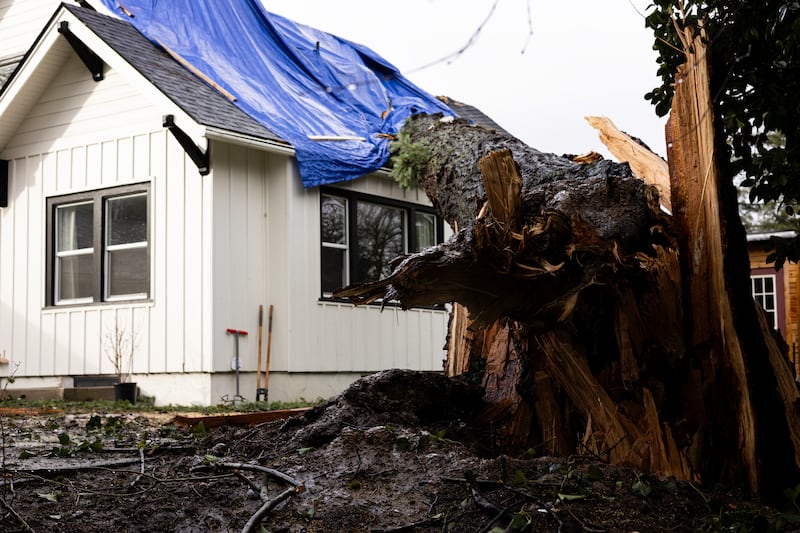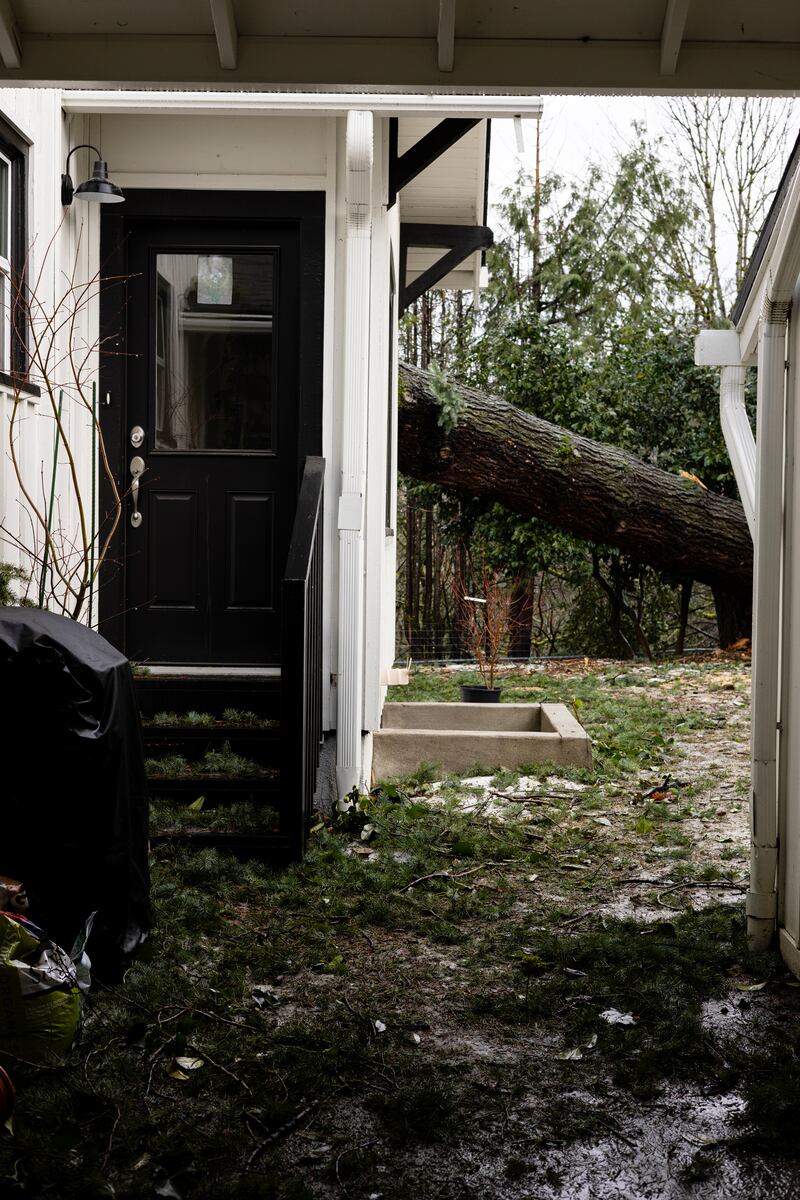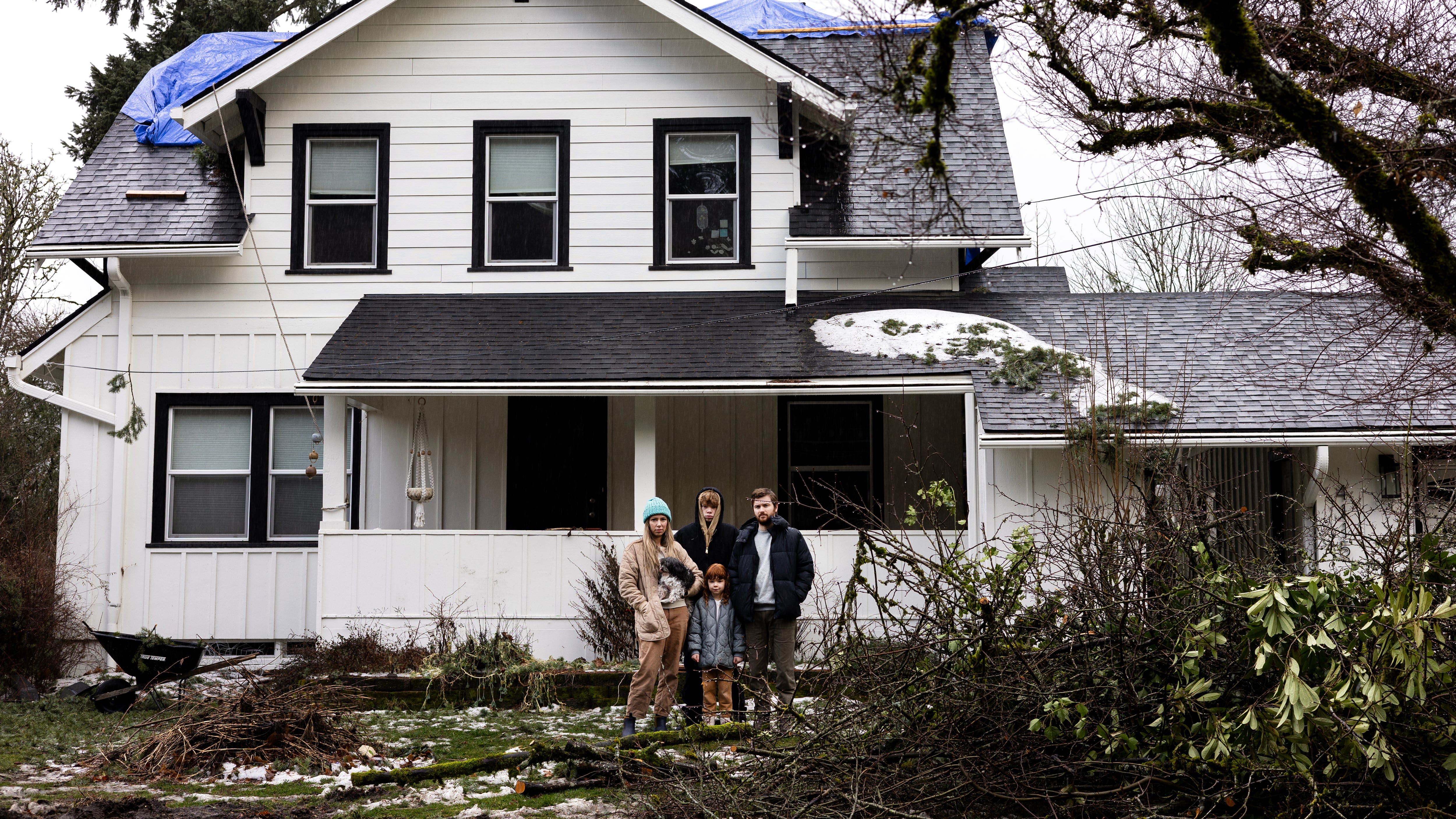On Jan. 13, the second day of a winter storm that paralyzed the region, a 150-foot Douglas fir crushed Sarah and Joel Bond’s Southwest Portland home.
“We just watched it come down and got out of the way,” recalls Peter Larkin, a neighbor who was standing in the Bonds’ living room with Joel when the tree crashed into the roof above the upstairs bathroom. “In those kinds of moments, the first thing is trying not to get squished.”
The Douglas fir smashed through the roof like a dull knife trying to cut through a tomato. It barely missed the Bonds’ 6-year-old daughter, JoJo, who was upstairs at the time. It sent one family cat, Binx, into hiding for the next eight days—the family presumed he was dead until he surfaced out of the basement on Jan. 21.
The Bonds were hardly alone in their misery. Last week’s storm was the most destructive winter weather event in recent history, and much of that destruction was accomplished by trees. Downed trees and limbs left 150,000 households without power; set a recreational vehicle on fire, killing a woman inside; and made many roads impassable. At least 11 fundraisers on the website GoFundMe are seeking money to assist with damages from trees that crashed into homes.
But for the Bonds, the destruction was especially galling—because they had been asking the city of Portland for permission to chop down the tree that hit their house since 2021.
“We tried to get these trees out because we were like, this looks potentially dangerous,” Sarah Bond says. “The possibility that it could happen seemed good enough reason for me to take them down.”
The city didn’t agree. In February 2022, the city’s Urban Forestry division denied the Bonds a removal permit for the two Douglas firs. “Removal will significantly affect neighborhood character, based on the tree’s attributes, visibility of the tree to the public, or past removals of trees in the area,” the city’s letter read. “Tree appears healthy and not dead, dying or dangerous at the time of inspection; tree is [more than 10 feet] from an attached structure.”
Now, the Bonds are without a home, and the city is requiring them to ask for a retroactive removal permit for the tree that fell. Plus, the Bonds will have to plant a new tree in its place.
“I have to pay them for their approval to remove the stump of the tree that destroyed our house that they denied us a permit on,” Sarah Bond says. “I am in complete disbelief.”
The Bonds’ story echoes complaints from across the city about Portland City Hall maintaining a high bar for chopping down a tree.
Brenna Bell, co-leader of the Shade Equity Coalition, which lobbies the city to more aggressively plant trees, fears that incidents of trees crushing homes and cars in the past two weeks will cause Portlanders to see trees as threats—not assets.
“I’m kind of afraid that people are going to look askance at trees after this weather event,” Bell says. “Danger comes from everywhere. You could have a door from an airplane fall on your house, you just never know.”

The city’s tree code is stringent for a reason: As the earth’s climate heats up, cities across the country are touting trees as one of the primary protectors of human life. After all, shade provides a reprieve from the heat, which in 2021 baked 69 Portlanders alive, most of them elderly, isolated and without air conditioning, and living in East Portland, where the tree coverage is scant compared to that on the west side of the Willamette River.
So the city has strict rules for homeowners who want to chop down a tree. If the trunk of a tree on your property is more than 12 inches in diameter, the city won’t allow you to chop it down unless it’s dead, dying or dangerous or less than 10 feet from a structure.
In September 2021, Joel Bond sent a form to the city of Portland’s Urban Forestry division, which , with an annual budget of $17.5 million and 84 full-time employees, handles all matters arboreal. Bond asked for permission to chop down two Douglas firs in the backyard, which towered over the house.
In a neat drawing on the back of the application, Bond sketched a diagram to help orient the city tree inspector. (“Unknown Shrubby Street Tree,” he labeled a nondescript tree near the front of the house. That one could stay.)
Five months later, the city sent back its denial letter. To fight the decision would cost $200. The Bonds decided not to appeal.
Almost two years later, Joel Bond and Larkin were talking about that tree—which looked all the more ominous sheathed in ice than it did bare—when it toppled onto the home’s second story.
“I hear snap, snap, snap,” Sarah Bond recalls. “My husband ran past me, straight to where my daughter was, in my bedroom. All I remember is walking up the stairs and screaming my daughter’s name. It was just silent.”
Joel Bond found their daughter JoJo, covered in dust from the tree crashing the roof, in their bedroom. She was unhurt.
They found one of their two cats, Max, hiding. The second cat, Binx, had been in the bedroom closet when the tree fell, and the closet, crushed by the tree, had fallen through the floor. The mangled closet now lay in the living room.
The Bonds, fearing it was dangerous to dig through the rubble, called for the cat. They heard nothing. They took their belongings and their daughter and left the house.
Even as the Bonds returned home each day to dig through the rubble looking for their cat, Sarah tried to get the ear of the city’s Urban Forestry division. She feared the second Douglas fir in the backyard would fall soon, too.
On Jan. 18, a city employee emailed Bond. She advised the family to hire an arborist to chop down the other fir and “document the situation since your photos will provide valuable documentation if you do have to apply for a retroactive permit.”
In other words, the Bonds can hire an arborist to chop down the second tree, but if the city deems an application insufficient or unconvincing, the applicant could be fined up to $1,000 per day that the violation isn’t remedied. (Parks bureau spokesman Mark Ross says penalties will vary based on the each case.)
To add salt to the wound: A later email from Urban Forestry on Jan. 22 told the Bonds they have to apply for a removal permit for the tree that already crushed their house, and they’ll also have to plant another in its place, out of their own pockets.
“I’m just livid,” Sarah Bond says.
Ross, the parks bureau spokesman, says a retroactive permit for the fallen tree is “certain to be approved” because a denial is issued only when a homeowner removes a tree “without evidence that an imminent hazard existed.” Says Ross, “Obviously not the case here.”
Still, the Bonds must plant a tree in the fallen one’s stead.
Corky Collier, executive director of the Columbia Corridor Association, a business group that has lobbied the city for years to soften its rules around tree removal, particularly in industrial areas, says the city should trust homeowners.
“The city’s concern about unnecessarily cutting down a tree,” Collier says, “seems to outweigh the possibility that the owner may have better insight and good intentions.”
Bell, the tree advocate, says making exceptions for tree removals can be a slippery slope. Most of the time, Bell says, trees are lifesavers—not killers.
“During the heat dome, trees saved lives,” Bell says, even though five trees fell on her own property during last week’s weather. “Most of the time, the tree is going to be your friend.”
The parks bureau said in response to questions about the Bonds’ situation that homeowners are ultimately responsible for maintaining trees on their property.
“Not all tree failures can be predicted, but through proactive maintenance engaging qualified tree care providers, property owners can learn their best options,” Ross says. “Property owners are responsible for keeping trees safe to prevent injury and damage to property.”
The fallen tree still lies atop the Bonds’ home. To their knowledge, city crews haven’t touched it yet.
On Sunday morning, Sarah Bond used a flashlight to inspect the basement of what remained of her home, carefully lifting pieces of rubble that didn’t look like they were holding back an avalanche of material from toppling down. She was looking for Binx’s carcass. Then, in the beam of her flashlight, she saw him.
Binx was tucked behind two of the basement’s beams, unharmed and blinking in the bright glare of the flashlight.

